Exporting/Importing Label Profiles
Overview
Label profiles that have been applied in an MCL-Designer project can be reused in other MCL-Designer projects. This is achieved with the use of the Library (a folder that stores reusable elements such as screens, programs, data files, etc.) and the export/import operations. In other words, you can export label profiles from a project into the Library and, then, import them, from the Library, into other MCL-Designer projects.
To Export a Label Profile to Library
Step-by step
1. Open the "Labels" module.
2. Right-click the label profile you want to export.
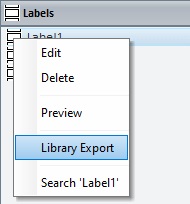
3. In the resulting menu, select "Library Export" to open the corresponding "Export to Library" window.

If required, select a different source Library or rename it by clicking ![]() . See To Define a Library.
. See To Define a Library.
4. Fill in the following options:
Label Information |
|
Label Name |
Maintain the suggestion or enter a new name. If there is a label profile in Library with the same name already and you persist in the export operation, the label profile already in Library will be overwritten by the new export. |
Text Box |
If required, add notes regarding the label profile being exported. |
Add Label Resources(x) |
Label profiles do NOT contain resources. However, you can append project resources to the label profile export. Check this option to append all the listed project resources to the selected label profile's export. |
![]()
It is possible to append project resources to the label profile's export, even though they are not a part of the label profile.
a. To view all project resources, click ![]() .
.
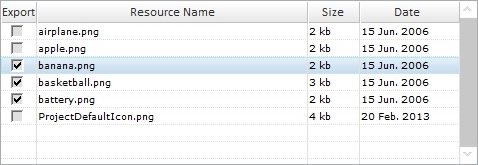
b. Check the project resources you want to include in the export. (If you have checked the "Add Label Resources" option, the corresponding resources will be selected when you expand the project's resource list.)
c. If you want, click ![]() to hide the resource list.
to hide the resource list.
5. Click ![]() to conclude the export.
to conclude the export.
![]()
As an alternative, you can use a drag-and-drop to initiate an export:
a. Open Library Manager (ex: with the shortcut key F4).
b. Drag the label profile you want to export and drop it in the Library Manager's window. This opens the corresponding "Export to Library" window.
c. Proceed as described in steps 4 and 5 ("To Export a Label Profile to Library").
The exported label profile is available in the Library ("Labels" section) and ready to be imported into another project.
If the library already contains a label profile with the same name, the following message box appears:
a. Click
OR
b. Click
|
To Import a Label Profile from Library
Step-by step
1. Open the destination project and use one of the following to access the "Library Manager" window:
a. Go to the Menu Bar, click "Tools" and, in the resulting menu, select "Library Manager".
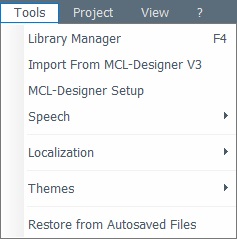
b. Click <F4>.
c. Right-click an empty area in the "Labels" module and select "Import Label" from the resulting menu.
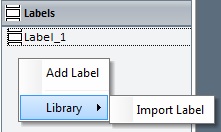
Whichever the option chosen (a, b, or c), it opens the "Library Manager" window.
If required, select a different source Library or rename it by clicking ![]() . See To Define a Library.
. See To Define a Library.
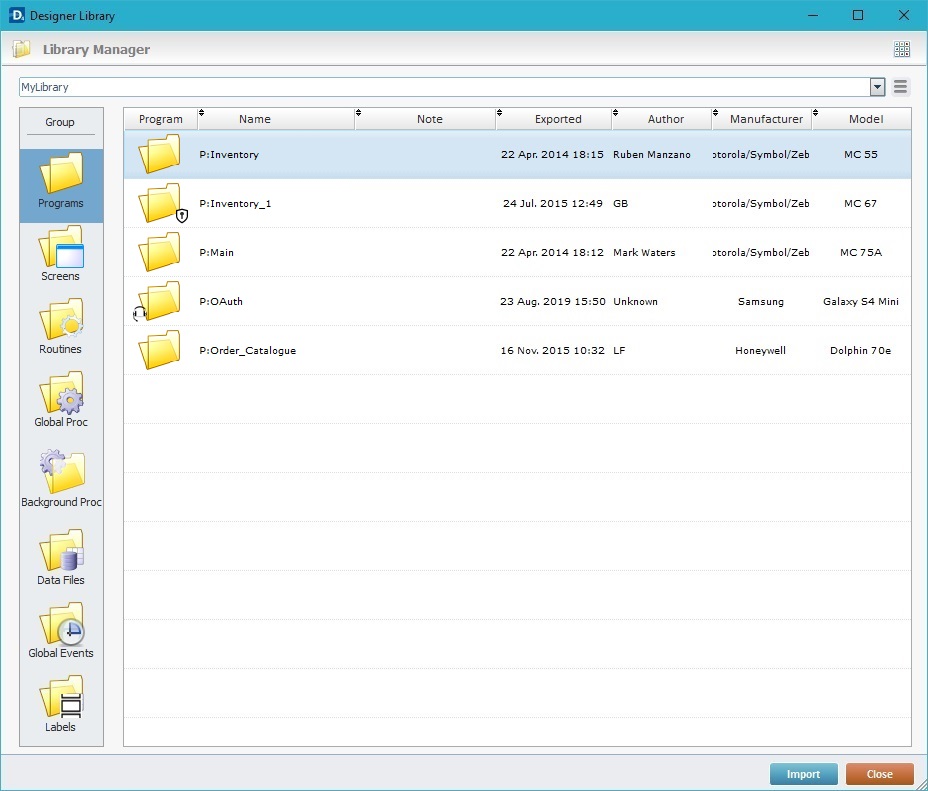
If you used the a or b option, continue to step 2.
If you used option c, proceed to step 3.
2. Select the element type ("Labels") you want to import in the "Group" section, to the left.
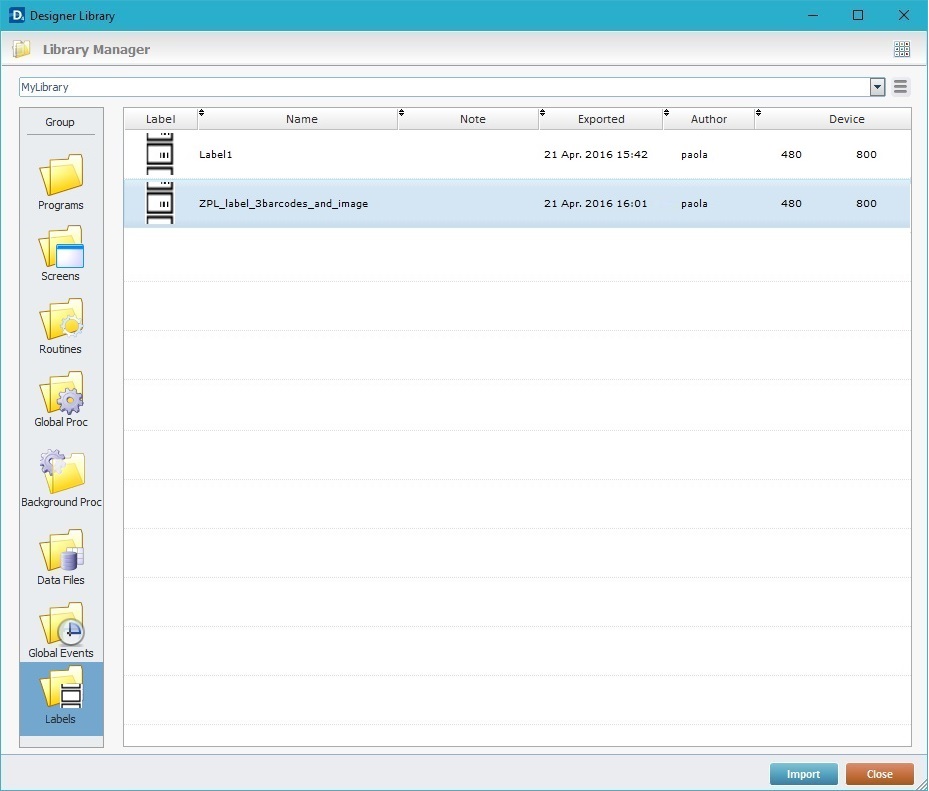
3. Use one of the following to open the "Import into Project" window of the label profile you want to import:
a. Double-click the label profile you want to import.
b. Drag-and-drop the intended label profile into the "Labels" module.

c. Select the intended label profile and click ![]() .
.
d. Right-click the selected label profile and click the "Import to Project" option.

The corresponding "Import into Project" window opens.

This window displays information that cannot be edited (regarding the label profile being imported) and information you can edit (the "Destination" section).
![]() If the destination project contains a label profile with the same name as the label profile being imported, the name of the imported label profile will automatically change to "..._X" ("X "refers to an incremental number).
If the destination project contains a label profile with the same name as the label profile being imported, the name of the imported label profile will automatically change to "..._X" ("X "refers to an incremental number).
4. Maintain or enter new information, as required by the project.
Import Label |
Displays the label profile's name. NOT editable. |
Displays the label profile's author and when it was added to the Library. It can also include notes entered during the export into Library operation. NOT editable. |
|
Destination |
|
Label Name |
Maintain the suggestion or enter a new name for the label profile.
|
Import Label Resources (x) |
Label profiles do NOT contain resources. However, if you have previously exported a label profile into Library with project resources, when you import that label profile into a new project, you have the choice to append those project resources to the label profile import. Check this option to append all the listed resources to the selected label profile's import. |
![]()
It is possible to attach project resources (appended during the label profile's export into the Library - see To Export a Label Profile to Library) to the label profile's import, even though they are not included in the label profile.
a. To view all project resources, click ![]() .
.

b. Check the project resources you want to include in the import. (If you have checked the "Import Label Resources" option, the corresponding resources will be selected when you expand the project's resource list.)
c. If you want, click ![]() to hide the resource list.
to hide the resource list.
5. Click ![]() to conclude the label profile import.
to conclude the label profile import.
The newly imported label profile is displayed in the "Labels" module and ready to be used in the project.
![]()
When the import includes language files (containing the imported element's localization tags), check the enabled languages of the destination project. If the imported language files relate to a language that is NOT enabled in the destination project, you have to define it as a project language in the project's Localization (a project properties tab). See Localization.
Ex: The import of a screen that includes a language file in "Dutch" into a project that only has "French" as an enabled language, will require that you add "Dutch" to the list of project enabled languages (in the "Localization" tab). If you skip this step, the imported "Dutch" language file will NOT be available for use.
![]() Click Here for an Example of an Import Error
Click Here for an Example of an Import Error
The •The destination program contains a screen with the same name as the one to be imported. •The destination project contains resources with the same name as the ones being imported.
|
![]() Click Here for an Example of Import Alert
Click Here for an Example of Import Alert
•The following message appears when the name of the element to import already exists in the destination and you have discarded MCL-Designer's name suggestion (the system automatically renames the element to import when there are two identical names) and entered the original name:
a. Click
OR
b. Click
|